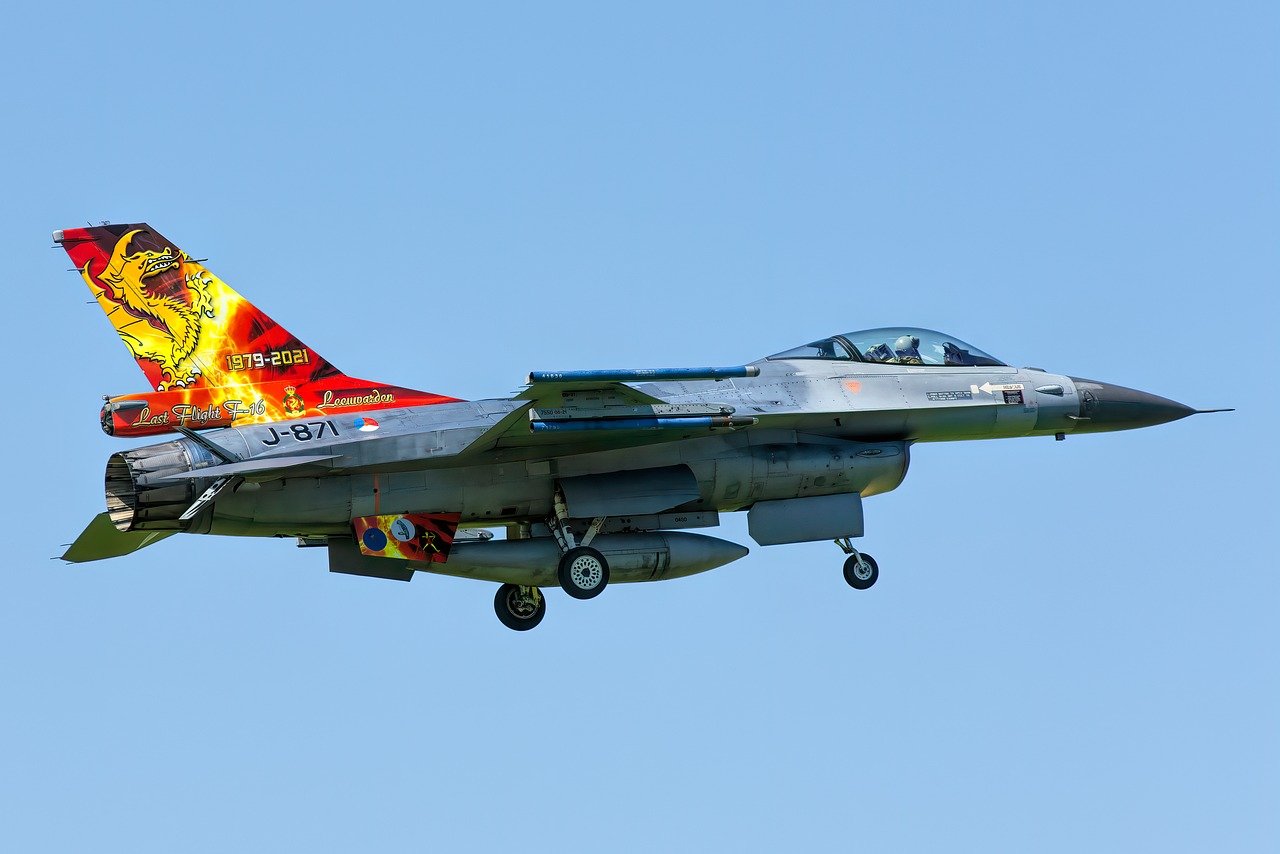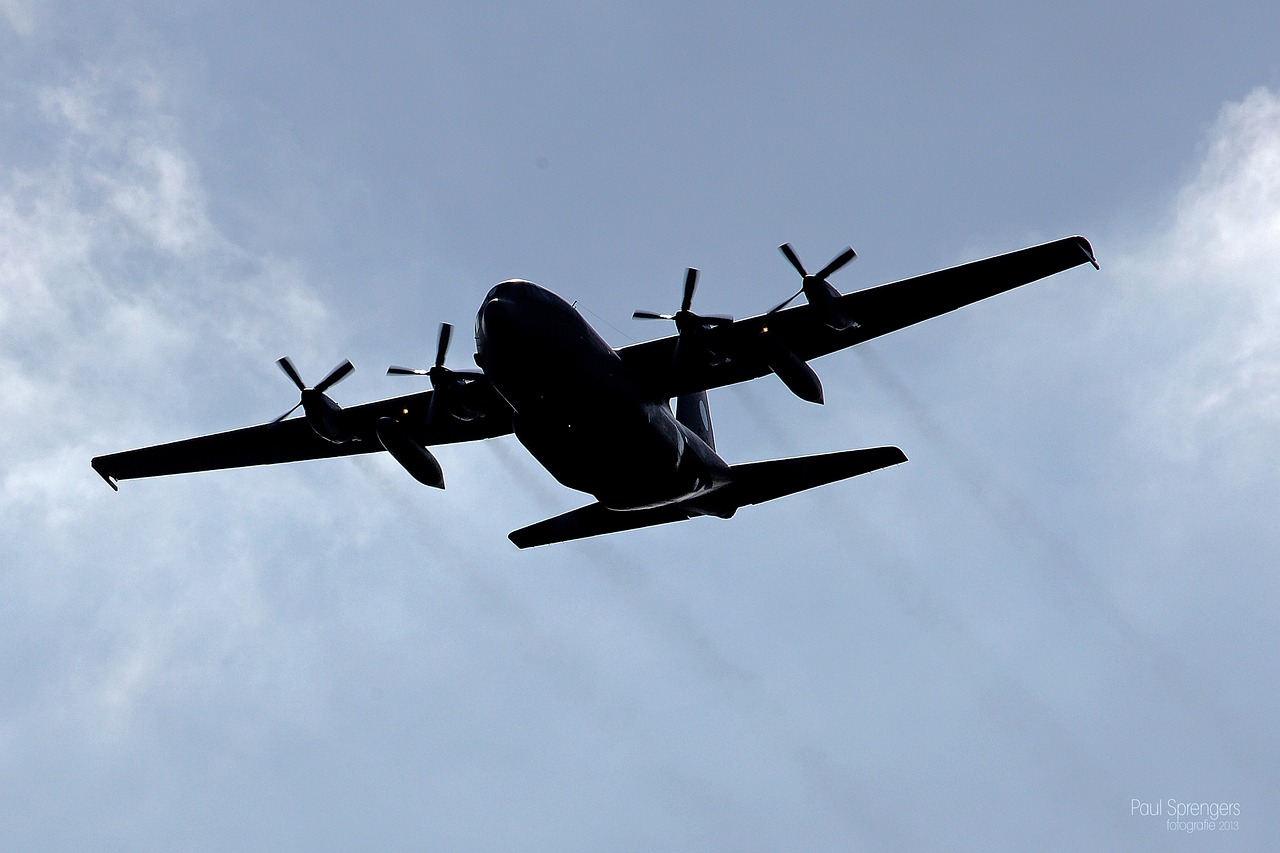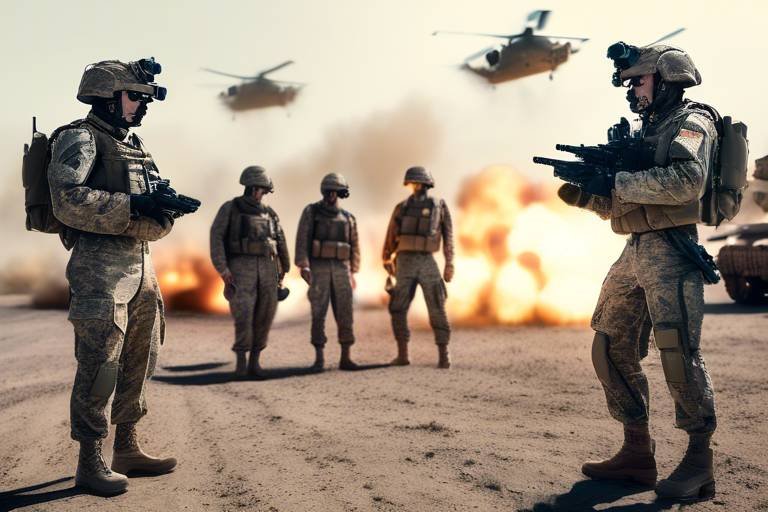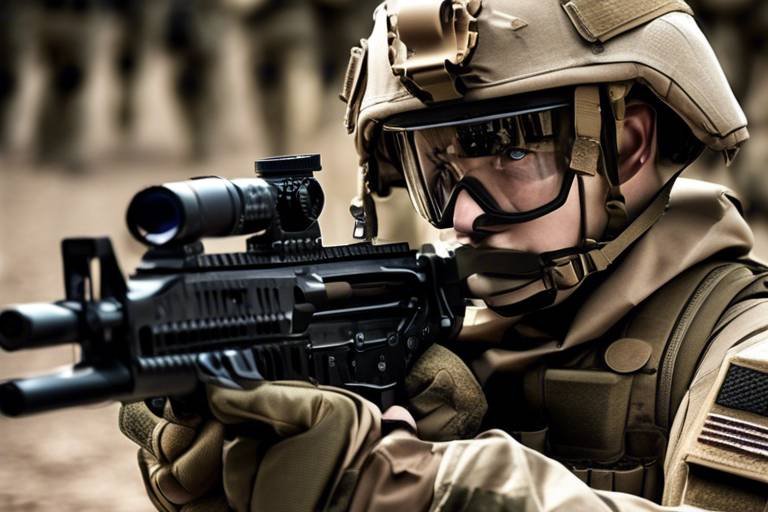How AI is Transforming Military Communication Strategies
In today's fast-paced world, artificial intelligence (AI) is not just a buzzword; it's a game changer, especially in the realm of military communication. Imagine a battlefield where information flows seamlessly, decisions are made in the blink of an eye, and strategies are crafted with pinpoint accuracy. This is the reality that AI is bringing to military operations. By leveraging advanced technologies and innovative methodologies, AI is enhancing operational efficiency, decision-making, and strategic planning like never before.
At the core of this transformation is the role of AI in streamlining military communication. Traditional communication methods often struggle with delays and inefficiencies, but AI is here to change that. With its ability to process and analyze vast amounts of data in real-time, AI ensures that critical information reaches the right personnel at the right time. This not only improves the flow of information but also enables military leaders to make informed decisions quickly, which is crucial in high-pressure situations. The integration of AI into military communication is akin to upgrading from a dial-up internet connection to high-speed fiber optics—everything becomes faster, more reliable, and more efficient.
Moreover, AI tools are designed to provide military leaders with data-driven insights. This means that instead of relying solely on intuition or past experiences, commanders can access real-time analytics that guide their decisions. Imagine being able to predict enemy movements or assess potential threats with a high degree of accuracy before they even materialize. This capability not only enhances situational awareness but also significantly improves response times, allowing military personnel to act swiftly and decisively. The implications for operational effectiveness are profound, as quicker decision-making can mean the difference between success and failure on the battlefield.
One of the most exciting aspects of AI in military communication is its ability to conduct real-time data analysis. This technology allows military personnel to sift through mountains of information almost instantaneously. For instance, during a conflict, AI can analyze communications, satellite images, and intelligence reports to provide a comprehensive overview of the battlefield. Such capabilities lead to superior situational awareness, enabling commanders to assess threats and opportunities with unprecedented clarity.
As we delve deeper, it's essential to highlight two key components that AI brings to the table: predictive analytics and automated reporting systems. Predictive analytics is a powerful tool that helps military strategists anticipate enemy movements and plan accordingly. By analyzing historical data and current trends, AI can forecast potential scenarios, allowing for better resource allocation and strategic planning. Think of it as having a crystal ball that not only shows you the future but also helps you prepare for it.
On the other hand, automated reporting systems reduce human error and accelerate communication. In the chaos of military operations, timely information dissemination is critical. AI-driven systems ensure that vital information is communicated promptly, reducing the risk of miscommunication and enhancing overall operational effectiveness. This automation is not just about speed; it's about ensuring that the right information is delivered to the right people at the right time, thereby facilitating more informed decision-making.
Another significant advantage of AI in military communication is its ability to bolster security. In an era where cyber threats loom large, protecting sensitive information is paramount. AI technologies are adept at identifying vulnerabilities and potential threats, ensuring that military communications remain secure from cyberattacks and espionage. By employing advanced algorithms to monitor and analyze communication channels, AI can detect anomalies and respond to threats in real-time, much like a vigilant sentinel guarding a fortress.
The impact of AI extends beyond communication; it also revolutionizes military training. AI-driven simulations create realistic scenarios that allow personnel to practice communication strategies in a controlled environment. This hands-on experience is invaluable, as it prepares military personnel for the complexities of real-world operations. Moreover, adaptive learning systems tailor training programs to individual needs, ensuring that each service member acquires the necessary skills to utilize AI tools effectively.
In addition, AI facilitates collaborative training environments where teams can practice communication strategies together. This teamwork is essential for successful military operations, as effective communication can often be the linchpin of mission success. By fostering collaboration and coordination, AI ensures that military units are well-prepared to face the challenges of modern warfare.
- How does AI improve military communication?
AI enhances military communication by streamlining processes, enabling real-time data analysis, and ensuring timely information dissemination. - What role does predictive analytics play in military operations?
Predictive analytics helps military strategists anticipate enemy movements and plan their operations more effectively. - How does AI ensure communication security?
AI identifies vulnerabilities and potential threats, monitoring communication channels to protect sensitive information from cyberattacks.

The Role of AI in Military Communication
This article explores the revolutionary impact of artificial intelligence on military communication, enhancing operational efficiency, decision-making, and strategic planning through advanced technologies and innovative methodologies.
Artificial Intelligence (AI) is becoming an integral part of military communication, revolutionizing how information is shared and processed within armed forces. Imagine a battlefield where every piece of data—be it intelligence reports, troop movements, or logistical updates—flows seamlessly, allowing commanders to make informed decisions in real-time. This is not a distant dream; it’s the reality that AI is helping to create. By streamlining processes, AI enhances the flow of information, ensuring that critical updates reach the right personnel without delay.
One of the key advantages of AI in military communication is its ability to analyze vast amounts of data quickly. In the past, military leaders often relied on human analysts to sift through mountains of information, which could lead to delays and potential oversights. Now, with AI, data analysis is performed in seconds, allowing for quicker responses to emerging threats. For instance, AI algorithms can process satellite imagery, social media feeds, and sensor data simultaneously, providing a comprehensive picture of the operational environment.
Moreover, AI tools can facilitate real-time data sharing among various units. This interconnectedness is crucial for modern military operations, where coordination between ground troops, air support, and naval forces can mean the difference between success and failure. With AI, communication channels can be optimized, reducing the risk of miscommunication and ensuring that everyone is on the same page. The result? Enhanced operational efficiency and improved teamwork, even in the most chaotic situations.
Additionally, AI plays a pivotal role in decision-making. Military leaders are often faced with high-stakes choices that require quick thinking and precise execution. AI provides data-driven insights that help these leaders evaluate options and consequences more effectively. By leveraging machine learning algorithms, military strategists can simulate various scenarios and outcomes, allowing them to make informed choices that could save lives and resources.
In summary, the integration of AI into military communication is not just a technological upgrade; it’s a paradigm shift. The ability to streamline processes, enhance data analysis, and improve decision-making capabilities transforms how military operations are conducted. As AI continues to evolve, we can expect even more sophisticated tools that will further enhance communication strategies within the armed forces.
- How does AI improve military communication? AI enhances military communication by streamlining processes, enabling real-time data analysis, and improving information flow among units.
- What are the benefits of real-time data analysis in military operations? Real-time data analysis allows military personnel to assess threats and opportunities more effectively, leading to superior situational awareness on the battlefield.
- Can AI help in decision-making during military operations? Yes, AI provides data-driven insights that allow military leaders to make quicker and more informed decisions, ultimately improving response times and operational effectiveness.

Enhancing Decision-Making with AI
In today's fast-paced military landscape, the ability to make quick, informed decisions can be the difference between success and failure. This is where artificial intelligence comes into play, revolutionizing the way military leaders approach decision-making. Imagine having a digital advisor that can sift through mountains of data, analyze it in seconds, and present actionable insights at your fingertips. Sounds like something out of a sci-fi movie, right? But this is the reality of AI in military operations.
AI tools are designed to provide military leaders with data-driven insights, which significantly enhances their ability to make timely decisions. Instead of relying solely on intuition or outdated information, commanders can access real-time data that reflects the current battlefield conditions. This shift not only improves response times but also increases operational effectiveness in high-pressure situations. For instance, when faced with an unexpected threat, having AI analyze the situation can lead to quicker and more strategic responses, potentially saving lives and resources.
The ability to analyze vast amounts of data in real-time is one of AI's most powerful features. Imagine a battlefield where every movement, every communication, and every piece of intelligence is being processed instantly. This capability allows military personnel to assess threats and opportunities more effectively, leading to superior situational awareness. With AI, commanders can visualize the battlefield in a way that was previously unimaginable, enabling them to make decisions based on the most current information available.
Another exciting aspect of AI in decision-making is the use of predictive analytics. This technology helps military strategists anticipate enemy movements and plan accordingly. Think of it as having a crystal ball that not only shows potential future scenarios but also provides insights into the best courses of action. By analyzing patterns and trends from historical data, AI can forecast possible enemy actions, allowing military leaders to allocate resources more effectively and devise strategies that enhance operational success.
Moreover, AI-driven automated reporting systems play a crucial role in enhancing decision-making. These systems reduce human error and increase the speed of communication, ensuring that critical information is disseminated promptly to relevant personnel. In the chaos of military operations, every second counts. An automated system that can generate reports and alerts in real-time allows decision-makers to focus on strategy rather than getting bogged down in administrative tasks.
In summary, the integration of AI into military decision-making processes is not just a trend; it’s a necessity in modern warfare. By leveraging real-time data analysis, predictive analytics, and automated reporting systems, military leaders can make informed decisions faster than ever before. This transformation is paving the way for a new era of operational efficiency, ultimately enhancing the effectiveness of military strategies and ensuring that troops are better prepared for whatever challenges lie ahead.
- How does AI improve military decision-making? AI enhances decision-making by providing real-time data analysis, predictive analytics, and automated reporting, allowing military leaders to make informed choices quickly.
- What are predictive analytics in military operations? Predictive analytics involves using historical data to forecast potential enemy actions, enabling military strategists to plan effectively.
- Can AI replace human decision-making in the military? While AI can assist in the decision-making process, it is not meant to replace human judgment. Instead, it serves as a powerful tool to enhance the capabilities of military leaders.

Real-Time Data Analysis
In the fast-paced world of military operations, has emerged as a game-changer. Imagine being on the battlefield, where every second counts, and having the ability to process vast amounts of information instantly. This is precisely what AI brings to the table. By harnessing advanced algorithms and machine learning techniques, military personnel can swiftly analyze data from various sources, including satellite imagery, drone feeds, and ground reports. The result? An unparalleled level of situational awareness that is crucial for making informed decisions.
One of the most significant advantages of real-time data analysis is its ability to provide actionable insights on potential threats and opportunities. For instance, AI systems can identify patterns in enemy movements, allowing commanders to anticipate attacks and deploy resources more effectively. In a way, it's like having a crystal ball that not only predicts the future but also suggests the best course of action. This predictive capability can be the difference between success and failure in high-stakes situations.
Additionally, the integration of AI in real-time data analysis enhances collaboration among military units. When multiple teams operate in different locations, sharing information can often be a bottleneck. However, AI facilitates seamless communication by aggregating data from various sources and presenting it in a digestible format. This means that whether troops are stationed on land, air, or sea, they can access the same critical information, ensuring everyone is on the same page.
To illustrate the impact of real-time data analysis, consider the following table that outlines the key benefits:
| Benefit | Description |
|---|---|
| Increased Situational Awareness | Allows for immediate understanding of the battlefield dynamics. |
| Faster Decision-Making | Enables commanders to make informed decisions quickly. |
| Enhanced Resource Allocation | Optimizes the deployment of troops and equipment based on real-time data. |
| Improved Threat Assessment | Identifies potential risks before they escalate into significant problems. |
Moreover, the ability to conduct real-time data analysis is not limited to just monitoring enemy movements. It extends to logistics, maintenance, and even personnel management. Imagine a scenario where AI analyzes the condition of military vehicles and predicts when they will require maintenance. This proactive approach ensures that equipment is always ready for action, reducing downtime and enhancing overall operational efficiency.
In conclusion, the transformative power of in military communication cannot be overstated. By leveraging AI technologies, military forces can achieve a level of responsiveness and adaptability that was previously unimaginable. As we move forward, the integration of these advanced analytical tools will continue to shape the future of military operations, ensuring that our forces remain a step ahead in an ever-evolving landscape.
- What is real-time data analysis in military communication?
Real-time data analysis refers to the immediate processing and evaluation of data to provide actionable insights during military operations. - How does AI improve decision-making in the military?
AI enhances decision-making by providing data-driven insights that allow military leaders to make informed choices quickly. - What are the benefits of using AI for real-time data analysis?
Benefits include increased situational awareness, faster decision-making, enhanced resource allocation, and improved threat assessment.

Predictive Analytics
Predictive analytics is revolutionizing the way military strategists operate, providing them with the tools to foresee potential threats and opportunities on the battlefield. Imagine having a crystal ball that not only predicts enemy movements but also suggests optimal responses based on a myriad of data points. This is precisely what predictive analytics offers. By leveraging advanced algorithms and machine learning, military analysts can sift through mountains of data—from troop movements to environmental conditions—and extract actionable insights that can significantly enhance operational planning.
One of the most compelling aspects of predictive analytics is its ability to analyze historical data and identify patterns that might not be immediately obvious. For instance, by examining past engagements, AI systems can uncover trends in enemy behavior, such as their preferred tactics or routes. With this information, military leaders can devise strategies that counteract these tendencies, effectively staying one step ahead. This dynamic approach not only improves the effectiveness of military operations but also optimizes resource allocation, ensuring that assets are deployed where they are most needed.
Moreover, predictive analytics can also aid in risk assessment. By evaluating various scenarios and their potential outcomes, military planners can weigh the pros and cons of different strategies. This enables them to make informed decisions that minimize risks while maximizing operational effectiveness. For example, if predictive models indicate a high likelihood of enemy ambush in a specific area, commanders can adjust their routes or deploy additional reconnaissance units to mitigate the threat.
To illustrate the significance of predictive analytics in military operations, consider the following table that outlines key benefits:
| Benefit | Description |
|---|---|
| Enhanced Situational Awareness | Provides real-time insights into enemy movements and environmental factors. |
| Improved Tactical Planning | Enables strategists to develop countermeasures based on predicted enemy actions. |
| Resource Optimization | Ensures efficient deployment of personnel and equipment by predicting needs. |
| Risk Mitigation | Helps assess potential threats and adjust strategies accordingly. |
In conclusion, predictive analytics is not just a technological advancement; it's a game-changer for military operations. By harnessing the power of data, military leaders can make quicker, more informed decisions that enhance their strategic edge. As we delve deeper into the age of AI, the role of predictive analytics will only grow, shaping the future of military communication and operations in ways we are just beginning to understand.
- What is predictive analytics in military operations? Predictive analytics involves using data analysis techniques to forecast future events, which helps military strategists anticipate enemy movements and plan effectively.
- How does predictive analytics improve decision-making? By providing data-driven insights, predictive analytics allows military leaders to make more informed decisions quickly, enhancing operational effectiveness.
- What types of data are used in predictive analytics? Historical data, real-time intelligence, environmental factors, and troop movements are some of the key data types analyzed to generate predictions.
- Can predictive analytics help in training military personnel? Yes, predictive analytics can identify skill gaps and training needs, allowing for tailored training programs that enhance the effectiveness of military personnel.

Automated Reporting Systems
Automated reporting systems are revolutionizing the way military communication operates. Imagine a world where critical information flows seamlessly without the bottlenecks often caused by human error or delays. These systems leverage artificial intelligence to generate reports automatically, ensuring that information is not only accurate but also delivered in real-time. This capability is crucial in military operations, where every second counts and the stakes are incredibly high.
One of the standout features of automated reporting systems is their ability to integrate data from multiple sources. This means that information from various battlefield sensors, reconnaissance missions, and intelligence reports can be compiled into a single, coherent report. The result? A comprehensive overview that allows military leaders to make informed decisions quickly. For instance, if a unit is under threat, the system can instantly analyze incoming data and produce a report detailing the situation, potential enemy movements, and recommended actions.
Moreover, these systems significantly reduce the workload on personnel. Instead of spending hours compiling reports, military staff can focus on strategic decision-making and operational planning. This shift not only enhances efficiency but also improves morale, as service members can devote their efforts to critical tasks rather than tedious paperwork.
To illustrate the importance of automated reporting systems, consider the following table that outlines their key benefits:
| Benefit | Description |
|---|---|
| Speed | Reports are generated in real-time, allowing for immediate action. |
| Accuracy | Reduces human error, ensuring that information is reliable. |
| Integration | Combines data from various sources for a holistic view. |
| Efficiency | Frees up personnel to focus on strategic tasks rather than administrative work. |
In addition to these benefits, automated reporting systems also enhance communication security. By utilizing advanced algorithms, these systems can detect anomalies or irregularities in data transmission, alerting personnel to potential cyber threats or espionage attempts. This proactive approach to security ensures that sensitive information remains confidential and protected.
In summary, automated reporting systems are not just a technological advancement; they are a game-changer for military communication. By streamlining processes, improving accuracy, and enhancing security, these systems empower military leaders to act swiftly and decisively in high-pressure situations. As we continue to embrace the capabilities of AI, the future of military operations looks more efficient and secure than ever before.
- What is an automated reporting system?
An automated reporting system is a technology that generates reports automatically using data from various sources, enhancing the speed and accuracy of information dissemination in military operations. - How does AI improve reporting in the military?
AI improves reporting by analyzing vast amounts of data in real-time, reducing human error, and ensuring that critical information is communicated swiftly and accurately. - What are the security benefits of automated reporting systems?
These systems enhance security by detecting anomalies in data transmission and protecting sensitive information from potential cyber threats.

Improving Communication Security
This article explores the revolutionary impact of artificial intelligence on military communication, enhancing operational efficiency, decision-making, and strategic planning through advanced technologies and innovative methodologies.
AI is becoming integral to military communication, streamlining processes, improving information flow, and enabling real-time data analysis to support tactical decisions and strategic operations.
AI tools provide military leaders with data-driven insights, allowing for quicker and more informed decision-making, ultimately improving response times and operational effectiveness in high-pressure situations.
The ability to analyze vast amounts of data in real-time enables military personnel to assess threats and opportunities more effectively, leading to superior situational awareness on the battlefield.
Predictive analytics helps military strategists anticipate enemy movements and plan accordingly, significantly enhancing the effectiveness of military operations and resource allocation.
AI-driven automated reporting systems reduce human error and increase the speed of communication, ensuring that critical information is disseminated promptly to relevant personnel.
In today's digital battlefield, the security of communication channels is paramount. AI technologies are stepping up to the plate, fortifying military communication systems against potential threats. Imagine a virtual fortress, where every piece of data is monitored and protected by sophisticated algorithms. These AI systems are designed to identify vulnerabilities in real-time, allowing military personnel to address potential breaches before they escalate into serious threats.
One of the key advantages of AI in communication security is its ability to analyze patterns and detect anomalies. By continuously learning from past incidents, AI can recognize unusual activities that may indicate a cyberattack or espionage attempt. This proactive approach not only safeguards sensitive information but also enhances overall operational integrity.
For instance, AI-driven systems can:
- Monitor Network Traffic: By analyzing data flow, AI can identify irregular patterns that could signify unauthorized access.
- Implement Encryption Protocols: Advanced algorithms ensure that all communications are encrypted, making it nearly impossible for adversaries to intercept and decipher critical information.
- Conduct Vulnerability Assessments: Regular assessments help pinpoint weaknesses in communication systems, allowing for timely upgrades and patches.
Furthermore, the integration of AI in communication security leads to a significant reduction in response times during security incidents. With automated alerts and real-time monitoring, military units can act swiftly to counter potential threats, ensuring that mission-critical information remains confidential and intact. In essence, AI acts as a vigilant guardian, constantly scanning the horizon for any sign of danger.
Military training is becoming more effective with AI-driven simulations that create realistic scenarios, allowing personnel to practice communication strategies in a controlled environment before real-world application.
Adaptive learning systems tailor training programs to individual needs, ensuring that military personnel acquire the necessary skills and knowledge to utilize AI tools effectively in communication.
AI facilitates collaborative training environments where teams can practice communication strategies together, enhancing teamwork and coordination essential for successful military operations.
Q: How does AI improve military communication security?
A: AI enhances military communication security by continuously monitoring data traffic, detecting anomalies, and implementing advanced encryption protocols to protect sensitive information from cyber threats.
Q: Can AI predict potential cyberattacks?
A: Yes, AI uses predictive analytics to identify patterns and behaviors that may indicate a forthcoming cyberattack, allowing military units to take preemptive measures.
Q: What role do adaptive learning systems play in military training?
A: Adaptive learning systems customize training programs to meet the specific needs of military personnel, ensuring they effectively learn to utilize AI tools for improved communication.

AI-Driven Training Simulations
In the ever-evolving landscape of military operations, the integration of artificial intelligence (AI) into training simulations is proving to be a game-changer. These AI-driven simulations create hyper-realistic environments that allow military personnel to practice and hone their communication strategies before they face real-world challenges. Imagine stepping into a virtual battlefield where every sound, movement, and decision mirrors the chaos of actual combat. This immersive experience not only prepares soldiers for the unexpected but also builds their confidence in handling high-pressure situations.
The beauty of AI-driven training lies in its ability to adapt and evolve. Traditional training methods often rely on static scenarios that can quickly become outdated. However, with AI, simulations can be dynamically adjusted based on the participants' actions and decisions. This means that no two training sessions are ever the same, providing a fresh and engaging learning experience each time. Military leaders can set specific objectives for their teams, and the AI can modify the training environment to ensure those objectives are met, pushing personnel to think critically and act decisively.
Moreover, these simulations are not just about individual performance; they emphasize teamwork and coordination. In military operations, communication is key. AI facilitates collaborative training environments where teams can practice their communication strategies together. For instance, during a simulated mission, squad members can engage in real-time discussions, share intelligence, and make tactical decisions as if they were on the ground. This collaborative aspect is crucial, as it mirrors the dynamic interactions that occur during actual missions.
One of the standout features of AI-driven training simulations is the incorporation of adaptive learning systems. These systems analyze the performance of each participant and tailor the training experience to meet their unique needs. For example, if a soldier struggles with a specific communication protocol, the AI can identify this gap and adjust the training scenarios accordingly, providing additional practice and resources to strengthen that area. This personalized approach not only enhances skill acquisition but also fosters a sense of ownership and accountability among personnel.
In addition to improving communication skills, AI-driven training simulations offer a safe space for experimentation. Soldiers can test different strategies and tactics without the fear of real-world consequences. This freedom to explore various options can lead to innovative solutions and tactics that might not have been considered otherwise. It’s like having a sandbox where military personnel can play around with ideas and learn from their mistakes, all while being guided by intelligent algorithms that provide instant feedback.
As we look to the future, the potential for AI in military training is limitless. With advancements in virtual reality (VR) and augmented reality (AR), the immersive experience will only become more pronounced. Imagine donning a VR headset and being transported to a foreign landscape where you must communicate with your team while navigating through obstacles and threats. This kind of training not only prepares soldiers for the battlefield but also enhances their ability to adapt to rapidly changing environments.
In conclusion, AI-driven training simulations are revolutionizing how military personnel prepare for their roles. By providing realistic, adaptive, and collaborative training experiences, these technologies ensure that soldiers are not only skilled in their individual tasks but also excel in teamwork and communication. As AI continues to evolve, so too will the methods we use to train our military forces, ultimately leading to more effective and efficient operations on the ground.
- What are AI-driven training simulations?
AI-driven training simulations are advanced training tools that use artificial intelligence to create realistic scenarios for military personnel to practice their skills and communication strategies. - How do these simulations enhance teamwork?
These simulations allow teams to practice communication and coordination in a controlled environment, mirroring the dynamics of real missions. - Can AI simulations adapt to individual needs?
Yes, AI-driven training systems can analyze individual performance and adjust training scenarios to address specific skill gaps. - What technologies are used in AI-driven training?
Technologies such as virtual reality (VR) and augmented reality (AR) are often integrated to create immersive training experiences.

Adaptive Learning Systems
In the ever-evolving landscape of military training, are revolutionizing the way soldiers acquire skills and knowledge. These systems are designed to customize training experiences based on individual performance and learning styles. Imagine trying to learn how to fly a fighter jet; some might grasp the concepts quickly, while others need more time and practice. Adaptive learning systems recognize these differences and adjust the training accordingly, ensuring that every soldier is equipped with the necessary competencies to excel in their roles.
One of the standout features of adaptive learning systems is their ability to analyze performance data in real-time. This means that as a soldier engages with training modules, the system tracks their progress and identifies areas where they may struggle. For instance, if a soldier consistently has difficulty with tactical communication under pressure, the system can provide additional resources or practice scenarios focusing specifically on that skill. This targeted approach not only saves time but also enhances the overall effectiveness of the training.
Furthermore, these systems often employ artificial intelligence (AI) to create dynamic training environments. By simulating various scenarios, adaptive learning systems can present challenges that vary in complexity based on the trainee’s skill level. This is akin to a video game that adjusts its difficulty based on how well you’re playing—if you’re breezing through the levels, the game becomes more challenging. In military training, this adaptability ensures that personnel are always engaged and pushed to improve without feeling overwhelmed.
Moreover, the integration of collaborative features within adaptive learning systems allows for team-based training. Soldiers can engage in group exercises that mimic real-world operations, enhancing their communication and coordination skills. For example, a squad can practice responding to a simulated attack, where each member must communicate effectively to achieve their objectives. The system assesses not just individual performance but also how well the team works together, providing feedback that is crucial for operational success.
To illustrate the impact of adaptive learning systems in military training, consider the following table that outlines key benefits:
| Benefit | Description |
|---|---|
| Personalized Training | Tailors learning experiences to individual needs, ensuring effective skill acquisition. |
| Real-Time Feedback | Provides immediate insights into performance, allowing for timely adjustments in training. |
| Enhanced Engagement | Keeps trainees motivated through varied and challenging scenarios that match their skill level. |
| Team Coordination | Facilitates collaborative exercises that improve communication and teamwork. |
In conclusion, adaptive learning systems represent a significant leap forward in military training methodologies. By leveraging AI and real-time data analytics, these systems create a more effective, personalized, and engaging training environment. As the military continues to embrace technology, the potential for improved operational readiness and success is boundless.
- What are adaptive learning systems?
Adaptive learning systems are educational technologies that customize training experiences based on individual performance and learning styles. - How do adaptive learning systems improve military training?
They provide personalized training, real-time feedback, and enhance engagement through tailored scenarios that match the trainee's skill level. - Can adaptive learning systems be used for team training?
Yes, these systems facilitate collaborative exercises that improve team communication and coordination. - What role does AI play in adaptive learning systems?
AI analyzes performance data and dynamically adjusts training scenarios, ensuring that each soldier receives the most effective training possible.

Collaborative Training Environments
In the dynamic world of military operations, effective communication is not just an asset; it’s a necessity. powered by artificial intelligence (AI) are revolutionizing how military teams prepare for real-world challenges. Imagine a scenario where soldiers, regardless of their geographical location, can engage in realistic training exercises that mimic actual battlefield conditions. This is no longer a dream; it’s a reality made possible by AI technology.
These environments enable teams to practice communication strategies in a safe and controlled setting. By simulating various scenarios, military personnel can develop their skills in conveying critical information swiftly and accurately. For instance, during a simulated mission, team members can face unexpected challenges that require immediate and effective communication. This not only enhances their ability to adapt but also fosters a sense of camaraderie and teamwork.
One of the standout features of AI-driven collaborative training is the ability to analyze group performance in real-time. AI systems can track how well teams communicate and coordinate their efforts, providing instant feedback that is crucial for improvement. Teams can engage in debriefing sessions where they review their performance, identify areas for enhancement, and strategize on how to tackle similar situations in the future. This iterative learning process is vital for honing communication skills, especially in high-stakes environments.
Moreover, AI facilitates the creation of customized training scenarios tailored to the specific needs of different units. For example, a special operations team may require training that emphasizes stealth and rapid communication, while a logistics unit might focus on efficient information flow regarding supply chains. By leveraging AI, military training can become more targeted and effective, ensuring that every team member is equipped with the skills they need to succeed.
The collaborative aspect of these training environments cannot be overstated. When personnel from different branches or units come together to train, they learn to communicate across various platforms and protocols. This cross-functional training is essential for real-world operations where collaboration between different military branches is often required. The ability to practice and refine these communication strategies in a collaborative setting prepares soldiers for the complexities they will face in actual missions.
In conclusion, AI-driven collaborative training environments are not just enhancing military training; they are redefining it. By creating realistic scenarios, providing real-time feedback, and fostering teamwork, these environments ensure that military personnel are not only prepared for the challenges ahead but are also capable of communicating effectively under pressure. As technology continues to evolve, so too will the methods by which we train our military, making the future of defense more efficient and effective than ever before.
- What are collaborative training environments? Collaborative training environments are platforms that allow military personnel to train together in simulated scenarios, enhancing their communication and teamwork skills.
- How does AI improve military training? AI improves military training by providing real-time feedback, analyzing performance, and creating customized training scenarios tailored to the needs of different units.
- Why is communication important in military operations? Effective communication is crucial in military operations as it ensures that teams can coordinate their efforts, respond to threats quickly, and execute missions successfully.
- Can AI-driven training environments be used for joint exercises? Yes, AI-driven training environments facilitate joint exercises by allowing personnel from different branches to practice communication and collaboration in a controlled setting.
Frequently Asked Questions
- What is the role of AI in military communication?
AI plays a crucial role in military communication by streamlining processes, enhancing information flow, and enabling real-time data analysis. This helps military personnel make tactical decisions faster and more effectively, which is vital in high-pressure situations.
- How does AI enhance decision-making in the military?
AI enhances decision-making by providing military leaders with data-driven insights. This allows for quicker responses and more informed choices, ultimately improving operational effectiveness and response times during critical missions.
- What are the benefits of real-time data analysis?
Real-time data analysis enables military personnel to assess threats and opportunities more effectively, leading to better situational awareness on the battlefield. It allows for immediate adjustments in strategy based on current conditions.
- How does predictive analytics contribute to military strategy?
Predictive analytics helps military strategists anticipate enemy movements and make informed plans. By analyzing patterns and data, it significantly enhances the effectiveness of operations and resource allocation.
- What are automated reporting systems?
Automated reporting systems powered by AI reduce human error and speed up communication. This ensures that critical information is shared promptly with the right personnel, which is essential for effective military operations.
- How does AI improve communication security?
AI strengthens communication security by identifying vulnerabilities and potential threats. This proactive approach helps protect sensitive information from cyberattacks and espionage, ensuring that military operations remain secure.
- What is the significance of AI-driven training simulations?
AI-driven training simulations create realistic scenarios for military personnel to practice communication strategies in a controlled environment. This hands-on experience is invaluable for preparing troops for real-world situations.
- How do adaptive learning systems work in military training?
Adaptive learning systems customize training programs to meet individual needs, ensuring that military personnel gain the necessary skills to effectively utilize AI tools in communication. This personalized approach enhances learning outcomes.
- What are collaborative training environments?
Collaborative training environments facilitated by AI allow teams to practice communication strategies together. This enhances teamwork and coordination, which are essential for successful military operations.



















